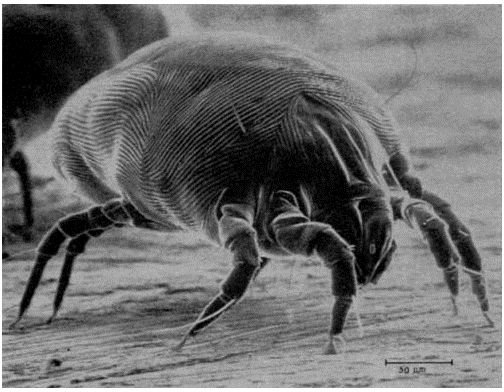Dust Mite Allergies: Symptoms and Testing for This Common Allergen in the Home
Ordinary house dust is one of the most common causes of allergy, especially respiratory allergy. A speck of dust can contain algae, bacteria, cotton fibers, feathers, hair, insect particles, lead, mold, pollen, street dirt, plaster, and more–whatever is in the air can float as dust.
In some people, the most allergenic ingredient of house dust is the dust mite. These are minute insects that are part of the arachnida family (like spiders or ticks) and feed on the flakes of skin that we normally shed daily. They cannot be seen with the naked eye and live in humid places. Dust mites are known to take refuge in bedding, pillows, carpet, upholstery, and stuffed toys. Both children and adults can have dust mite allergies.
Reactions and Symptoms
An allergy to dust mites is a reaction in the immune system to the mite’s protein. This substance causes an inflammatory reaction in the body. When you breathe in the mite debris, the body’s immune system responds with an allergic reaction. This can inflame the lining of the nasal passages, causing hay fever symptoms such as sneezing, runny nose, and congestion. For other people, this dust mite allergy causes respiratory symptoms with inflammation and constriction of the lungs, which is asthma. The complaints of asthma are wheezing, shortness of breath, and coughing. These are the general symptoms; however, dust mites can cause other subsets of these two major reactions.
If you have a hay fever reaction, you may also complain of:
- Itchy and red eyes
- Itchy nose
- Itchy roof of the mouth
- Postnasal drip
- Coughing
- Facial pain and pressure
- Dark colored skin under the eyes (allergic shiners)
- Upward rubbing of the nose, mostly with children
If you are asthmatic, allergies to dust mites may also cause:
- Chest tightness
- Chest pain
- Sleep disturbances due to asthma symptoms
Ways to Determine This Type Allergy
Sometimes a person can tell if dust is an irritating problem. Do you experience symptoms when you are dusting and cleaning the house? Do you feel worse in the morning after sleeping in bed? Do your allergy symptoms increase after lying down on a carpeted floor? These are observations you can make and report to your doctor.
Doctors have ways of testing for dust mite allergies. First, he may examine your nose to see if it is inflamed, swollen, or bluish in color. An allergist may conduct skin testing to see if dust mites are a problem for you. A small amount of dust mite extract is pricked into your skin’s surface (either the back or arm). If after a period of time you develop a wheal (bump) or itching, the reaction is measured and determined if you have an allergy to this offender. Blood tests (RAST or ELISA) are also used to see if a person’s blood produces allergy-causing antibodies to dust mites and how sensitive you are to the allergen.
Dust mite allergies can be an ongoing, and can be somewhat controlled with proper cleaning, encasing of bedding, and medications. Don’t get too obsessed about getting rid of dust; unfortunately, it is everywhere and endless.
References
“Dust Mite Allergy” https://www.mayoclinic.com/health/dust-mites/DS00842
The Allergy Self-Help Book by Sharon Faelten [Rodale Press,1983]
Photo credit: https://commons.wikimedia.org/wiki/File:House_Dust_Mite.jpg
